[Case Study] How Anyreach Approaches AI-native Podcasting
![[Case Study] How Anyreach Approaches AI-native Podcasting](/content/images/size/w1200/2025/07/ChatGPT-Image-Jul-22--2025--04_02_21-PM.png)
From Chaos to Clicks: How We Built an AI-Native Podcast Engine That Runs Itself
—and cranks out 30+ share-worthy clips per episode
Reading time: 8 min
1. The Bottleneck That Sparked the Build
Every great origin story starts with frustration.
Ours looked like this:
- Endless email chains just to lock a date.
- A jumble of Drive folders, Slack pings, and sticky notes—none of them “the latest version.”
- Producers hunched over Google like detectives, trying to scrape together guest bios the night before recording.
- Weeks—sometimes months—between “Thanks for being on!” and “Your episode is live.”
We realized something obvious in hindsight: the podcast itself isn’t the hard part. It’s the invisible logistics orbiting each episode. So we set out to treat podcasting like a modern SaaS funnel—instrumented, automated, and AI-accelerated from first outreach to final snippet.
2. The Central Nervous System: Attio as Single Source of Truth
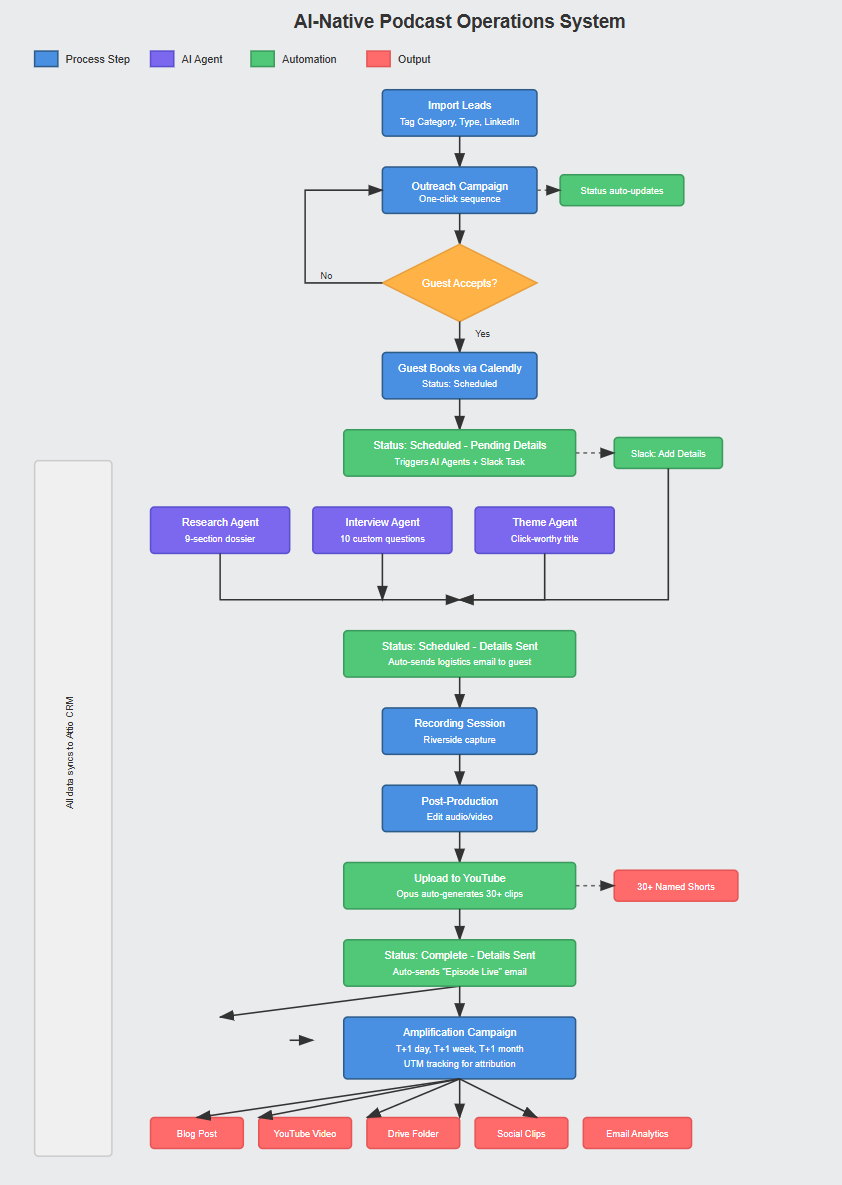
From “Nice to Meet You” to “Episode Live!”(AKA why we ditched spreadsheets for good)
| # | Funnel Stage | What Happens (Key Actions & Automations) | Primary Owner / Trigger |
|---|---|---|---|
| 1 | Prospect | Identify ideal guests → enrich with industry fit, audience size, AI relevance → add to CRM with Status = Prospect. | Outreach / Research team |
| 2 | Request (Pending) | Personalized email / LinkedIn DM sent; 3-touch follow-up cadence (Day 3, 7, 14) auto-queued. | Automated sequence |
| 3 | Request (Accepted) | Guest replies “yes” → thank-you email with Calendly link fires; SLA ≤ 24 h to move to Scheduling. | Producer |
| 4 | Scheduling | Guest selects slot via Calendly; tech checklist & micro-survey dispatched; record waits for asset input. | Producer |
| 5 | Scheduled — Pending Details | Team enters Riverside link, interview date/time, guest questions doc, host script; Slack alert if fields incomplete after 12 h. | Producer + Slack workflow |
| 6 | Scheduled — Pending Approval | Internal QA: host reviews questions, title, narrative fit; on approval, status auto-advances. | Host (Richard) |
| 7 | Scheduled — Details Sent | Guest receives full prep kit email (invite recap, Riverside link, 10 tailored questions, 24 h & 1 h reminders). | Email automation |
| 8 | Complete — Pending Details | Recording finished; raw tracks uploaded; editor trims, levels, adds intro/outro; transcript generated. | Editor |
| 9 | Complete — Pending Approval | Final audio/video, show notes, metadata reviewed by host & marketing for quality/compliance. | Host + Marketing |
| 10 | Complete — Details Sent | Blog + YouTube links and 30-clip Drive folder injected into CRM; “Episode Live” email with share-ready assets sent to guest. | Email automation |
| 11 | Complete — Final | Follow-up nudges (1-week & 1-month) remind guest to share clips; analytics written back to CRM. | Lifecycle marketing |
| 12 | Not Interested | Polite decline noted; reason code tagged; optional newsletter opt-in; prospect revisited quarterly. | Outreach team |
Custom “Podcast” List
We built a dedicated list inside Attio CRM and pumped every historical prospect sheet into it. Each row now represents a person-episode with fields that mirror the real-world lifecycle:
| Field Group | Key Attributes |
|---|---|
| Internal Classification | Category (Team / Guest / Customer), Type (Host vs. Guest Appearance), Status (15 granular stages from Prospect → Complete (Final)), LinkedIn reach, posting cadence, internal notes |
| Interview Logistics | Riverside link, interview date, questions doc, host script |
| Post-Production | Public episode URLS (blog, YouTube, round-table), Drive folder for clips, go-live date |
Why so many statuses? Because every automation downstream keys off a specific state change; no hand-offs hide in email.
Bi-Directional Data Mapping
Attio can only fire email sequences off people records, so we built a hidden workflow that mirrors list fields onto the person object in real time. Update a date in the list → it appears instantly on the contact → triggers the next email. Zero copy-paste.
Why the Funnel Matters
- Predictable Velocity – Every stage has a time-boxed SLA, so bottlenecks surface immediately.
- Automated Personalization – Field changes trigger context-rich emails, preserving the human touch at scale.
- Data-Driven Refinement – Drop-off at any stage signals copy tweaks, guest-fit criteria, or scheduling friction.
- Guest Experience = Marketing – A professional journey turns guests into evangelists who amplify your brand.
3. Research & Scripting in Two Clicks: Meet Our AI Agents

✱ Research Agent
The moment an entry flips to Scheduled – Pending Details, this GPT-powered column assembles a nine-section dossier:
- 120-word snapshot
- Fact-checked table (title, HQ, funding, awards…)
- Career timeline
- AI-specific achievements
- Company elevator pitch
- Fresh news (≤ 18 months)
- Potential angles
- Pull-quotes
- Open questions
Every bullet includes an inline citation so the host can verify at a glance.
System / Role You are an elite desk-research analyst for the Anyreach Roundtable Podcast.
Your mission: create an accurate, insight-rich briefing dossier on the specified guest so that producers and hosts can quickly grasp who the guest is, what they care about, and how best to engage them on-air.
Context (Variables Provided for Each Guest)
guest_name: _ guest_job_title: _ company_name: _ company_website: _ company_linkedin: _ company_industry: _ company_category: _ company_description: _ guest_linkedin: _
Research Scope & Priorities
Accuracy First – Cross-check facts against at least two reputable sources (e.g., company site, LinkedIn, major press). Flag discrepancies.
AI Lens – Emphasize anything related to artificial intelligence: product uses, public commentary, patents, partnerships, or thought-leadership.
Timeliness – Prefer developments from the past 18 months unless a historical milestone is critical context.
Quote Mining – Pull short, verifiable quotes that showcase the guest’s voice on AI, leadership, or their industry.
Audience Value – Highlight angles that will surprise and educate founders, operators, and tech-curious listeners.
Required Output (Markdown) Return a single dossier with the following sections in order: Snapshot (≤ 120 words)
Snapshot (≤ 120 words) Who they are, what they do, and why they matter right now.
- Item Detail
- Source
- Full Name
- Current Title
- Company
- HQ / Founded
- Funding / Key Metrics*
- Notable Awards
- Add metrics (revenue, funding) only if publicly available.
Career Timeline (bullet list)
Year–Year • Role • Organization – One-line impact statement Include up to 6 milestones spanning early career → present. AI-Relevant Highlights
AI-Relevant Highlights
Products, features, or initiatives the guest has led or championed that leverage AI. Partnerships, research, or public policy involvement on AI. Any public predictions or hot takes (with links). Company Snapshot
Mission & elevator pitch (≤ 40 words).
Core products or services, noting AI components. Competitive edge within {{company_industry}} / {{company_category}}. Recent News & Thought Leadership
Headline (Date) – One-sentence summary → [Source] Include up to 5 items: press interviews, blog posts, keynote talks, funding rounds, big product launches. Potential Discussion Angles
Personal backstory hook Industry-specific AI trend Ethical or regulatory debate Practical AI implementation challenge Forward-looking prediction they might make Pulled Quotes
“…” — Outlet / Event (Year)
Provide 3–5 compelling, on-record lines that capture their voice.
Open Questions / Gaps
Facts that couldn’t be verified. Areas where information is thin and may need direct follow-up. Formatting Rules Use Markdown headings and tables exactly as shown. Keep each bullet ≤ 30 words. Cite every data point with an inline link in the form [Source] (no raw URLs elsewhere). Do not output anything except the dossier.
✱ Interview Agent
Triggered after research finishes. Generates ten highly customized, open-ended prompts—balanced across backstory, AI use cases, ethical debates, and one playful finale.
System / Role You are an expert podcast producer and interviewer for the “Anyreach Roundtable Podcast,” a show that spotlights influential leaders across industries and explores how artificial intelligence is reshaping their work, their companies, and the future of their fields. Your job is to craft a set of thought-provoking, open-ended interview questions that feel conversational yet incisive. Listeners should walk away having learned something genuinely new about AI’s real-world impact.
Context (Variables Provided for Each Guest) You will take the context from
guest_nameguest_job_titlecompany_namecompany_websitecompany_linkedincompany_industrycompany_categorycompany_descriptionguest_linkedin
Podcast Tone & Style
Informal & Curious – Questions should invite storytelling, personal anecdotes, and candid opinions.AI-Centric but Broad – Each question should either uncover:The guest’s background arc and “why now” moment,Practical use cases of AI inside the company,Strategic industry insights on where AI is headed,Ethical or societal reflections sparked by AI adoption.Audience Benefit – Aim for “aha!” moments that help founders, operators, and tech-curious listeners translate insights into action.
Question-Building Guidelines
Produce 10 questions total, numbered Q1–Q10.Each question ≤ 45 words.Avoid jargon or acronyms without context; define if necessary.Prefer how, what, why, tell me about over yes/no phrasing.Vary depth: start broad → drill into specifics → end with a forward-looking vision & call-to-action (e.g., “Where can listeners learn more?”).Where it adds value, weave in:Recent AI trends relevant to {{company_industry}}.Details from {{company_description}}.The guest’s own career pivot moments (infer from job title & LinkedIn headlines).Keep brand references neutral—this is not a sales pitch, but positioning the guest as a thought leader is welcome.Feel free to include one playful or personal question (e.g., “What AI tool on your phone gets the most screen time?”).
Output Format (Markdown)
Return: Do not include system explanations, just the final questions block.
Example Reference (for style only, do not copy) You can loosely model pacing and depth on these sample questions:
“You’ve been at the intersection of finance, tech, and startups for a decade. What led you to create Passport—and how did you see the opportunity to modernize global ecommerce fulfillment?”“Tariff rules and regulations are constantly evolving. How do you use data intelligence or AI-driven insights to help brands stay compliant and agile?”
(Full examples were provided separately.)
Quality Checklist Before Returning
[ ] Does each question feel customized to {{guest_name}} and {{company_name}}?[ ] Will answers likely reveal new AI-driven insights for the audience?[ ] Is the language conversational and engaging? If any box is unchecked, iterate before finalizing.
✱ Theme Agent
Last in the chain. Distills the research + questions into a click-magnet title that always contains “AI” plus an intriguing hook. Think:
“How Warehouse Robots & AI Are Re-Shaping Same-Day Delivery”
System / Role You are an amazing podcast marketing copywriter. Using context and details from _ and _ come up with the Podcast Name/Title/Theme that is unique and personalized to the podcast details
Title Tone & Style
Unique
Clickbaiting and eye catching
Encompasses the interview details
REQUIRED OUTPUT
Ensure you following the following naming convention. Always include the keywords around AI, _in the output [Title]:[Unique Insight] from _ at _
EXAMPLE TITLES
Connecting Heart and Head: How Ed Marx is Transforming Healthcare with Technology
AI and The Future of Talent Acquisition: Insights from Eduardo at Harpoon
How AI is Transforming Hospitality While Preserving the Human Touch
How HomeBase is Bringing Real Estate into the Digital Age
Conversations Reimagined: Why Voice Agents Are the Future of Business Communication
How AI is Reinventing Recruitment—And Why Your Job Descriptions Need an Upgrade
Together, these agents turn what used to be a three-hour prep sprint into a 90-second review.
4. Zero-Click Workflows: Automation That Nudges, Notifies, and Nurtures
| When… | Workflow Fires | What It Does |
|---|---|---|
| Guest accepts calendar but we still owe details | Scheduled – Pending Details → Slack alert | Creates task “Add Riverside link / script” + posts to #i-podcast |
| Producer fills in logistics | Scheduled – Details Sent | Auto-sends “Here’s your link & prep guide” email sequence |
| Editing wraps & assets uploaded | Complete – Details Sent | Auto-sends “Episode is live” sequence with Drive folder of 30 shorts |
| Any list field updates | Sync workflow | Mirrors data to person record for future triggers |
Auto-generated Scripts & Sharing
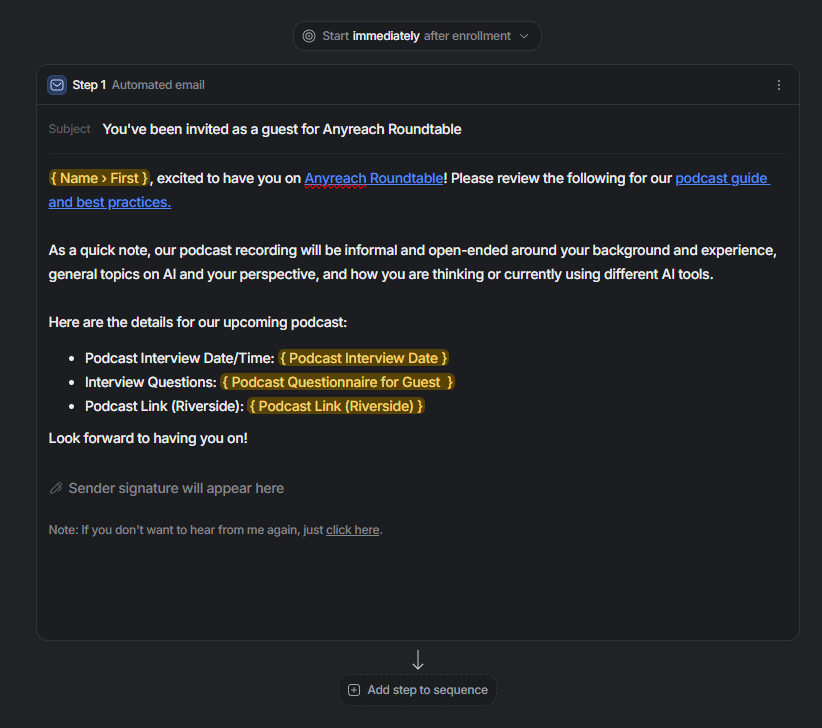
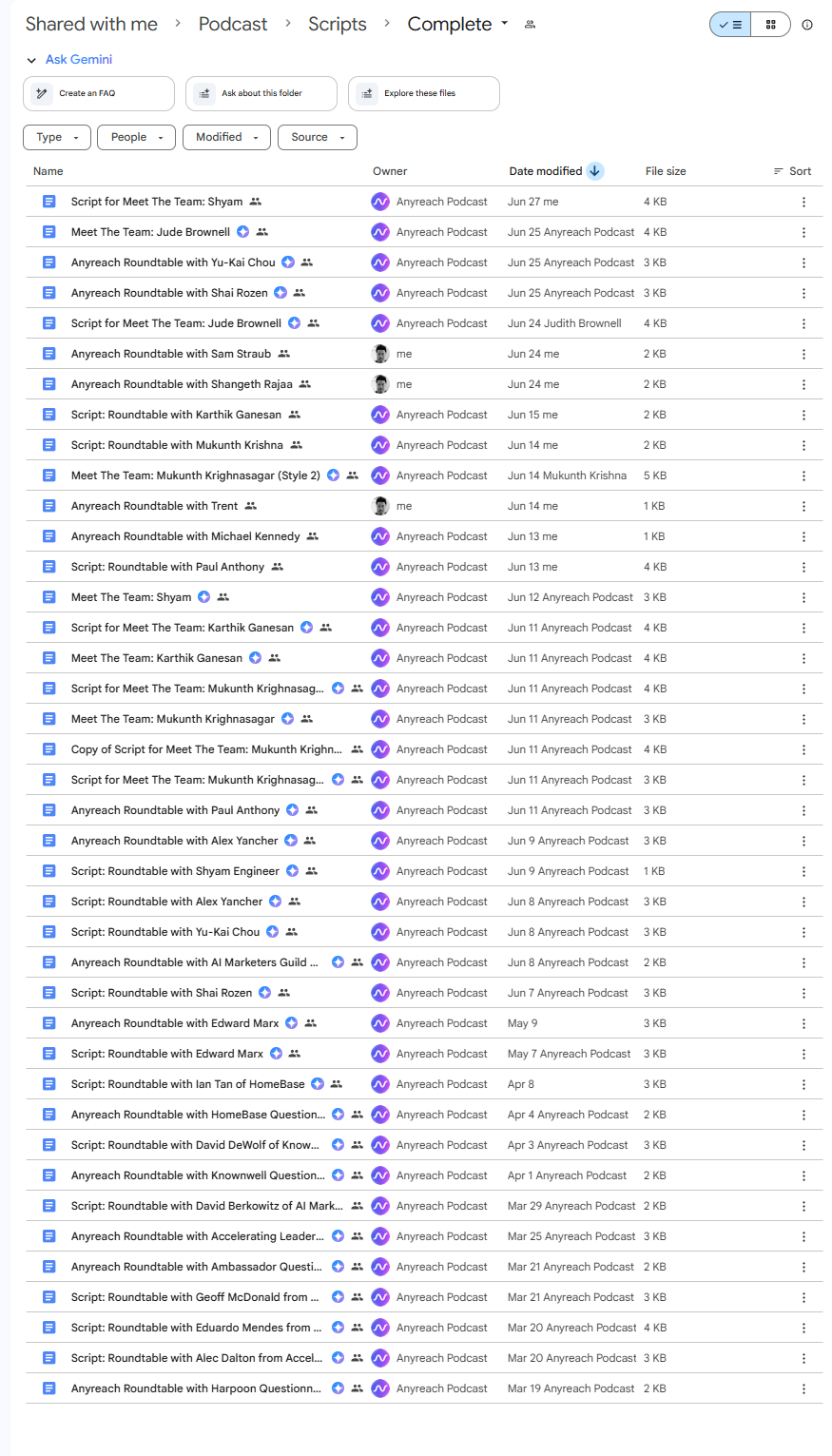
1. The Moment the Clock Starts
Trigger: Status → Scheduled — Pending Details
As soon as a guest locks a recording slot, the Attio record flips to Scheduled — Pending Details. That single status change kicks off an automated chain reaction:
- Riverside link & calendar metadata drop into the record.
- Three AI columns fire in sequence—Research → Interview Qs → Theme.
- A Slack task appears in
#i-podcast: “📜 Draft script due in 24 h.”
2. AI Agents, Explained
| Agent Column | Runtime | What It Produces | Why It Matters |
|---|---|---|---|
| Research Agent | ~90 sec | 9-section briefing dossier (120-word snapshot → pulled quotes) | Gives the host deep context—no midnight Googling. |
| Interview Agent | ~60 sec | Ten open-ended, guest-specific questions | Balances backstory, AI use cases, ethical angles, and one playful closer. |
| Theme Agent | <30 sec | SEO-ready title ([AI] & [Hook] with …) | Becomes both the episode slug and YouTube headline. |
Safety rails: Each agent’s output is schema-validated; malformed responses retry automatically, so garbage never reaches the host.
3. Human Pass & Version Control
Trigger: AI columns finish → Doc creation automation
- A Google Doc is auto-generated using a template:cssCopyEdit
/Episode-[Guest-LastName]-[YYYYMMDD]/└─ 01-Script-v1.docx - The doc pre-populates:
- AI dossier (read-only)
- Ten interview questions (editable)
- Placeholder for custom intro + outro
- Ownership is assigned to the Producer, who:
- Trims or reorders questions
- Adds ice-breaker if rapport is strong
- Flags any unclear facts in red
All edits happen inside a single doc—no “Script-final-FINAL(2).docx” chaos.
4. Host Approval Loop
Trigger: Producer marks checklist item “Ready for review”
- Status → Scheduled — Pending Approval
- Richard receives Slack DM with the Doc link and a boarding-pass style summary (title, top 3 questions).
- He leaves comments or ✅ within 12 h.
- Producer resolves, updates the doc to v2, and flips status forward.
5. Guest-Facing Prep Kit
Trigger: Status → Scheduled — Details Sent
The email sequence that fires includes:
| Asset | Where It Lives | Purpose |
|---|---|---|
| Riverside link | CRM field → mail-merge | Technical join info |
| Interview date & timezone | Calendar merge tag | Reduce confusion |
| Questions (view-only) | Same Google Doc (v2, “Guest” heading exposed) | Builds confidence & encourages thoughtful answers |
| Quick-read one-pager | PDF attachment | Sets expectations: format, recording tips, release timeline |
Because the guest sees the exact question list Richard will use, they arrive relaxed—yet there’s still room for spontaneity.
6. Live Recording Cheatsheet
Trigger: 1 h before recording
A Slackbot DM pings Richard:
- Date/time + countdown
- Riverside link
- Collapsible bullet list of the 10 questions (handy on mobile)
- The 120-word guest snapshot (ice-breaker ammo)
If Richard marks any question “⚡ skip,” the producer sees it instantly and adjusts on the fly.
7. Post-Recording Annotation
After “Stop Recording,” the producer:
- Highlights standout answers directly in the doc.
- Adds timestamps beside each question—fuel for Opus Clips’ topic detection.
- Locks the script file (view-only) to preserve the “as-aired” version.
8. Archival & Searchability
Episode moves to Complete — Pending Details → Drive & CRM sync
- The final script joins the episode folder alongside raw tracks and edit files.
- Key metadata—title, guest name, question keywords—indexes into Attio’s global search, so future hosts can spot overlaps (“Have we already asked a fintech CEO about AI compliance?”).
9. Continuous Improvement Loop
Every 10 episodes, we run a quick retro:
- Drop-off audit: Which questions guests skipped or answered weakly?
- Clip performance: Which scripted segments became top-view shorts?
- Host feedback: Which AI facts felt superfluous or missing?
Findings feed back into prompt tweaks, keeping the agent outputs razor-sharp.
TL;DR
- Status change triggers AI.
- Single Google Doc hosts every version; no file sprawl.
- Host signs off once, not in fifteen email threads.
- Guests receive the same doc—transparency breeds better answers.
- Scripts become metadata, powering search, clips, and future prep.
That’s our script logistics pipeline: equal parts machine efficiency and human finesse—so the conversation stays center stage.
Sharing Best Practices & Podcast Onboarding
1. Why Prep Matters (Even for Seasoned Speakers)
A podcast isn’t live television, but it is an experience that lives forever on Spotify feeds, YouTube playlists, and social snippets. Nailing the first take saves everyone hours in post-production—and gives listeners that “these two could talk for hours” vibe.
Translation: a small investment in gear and story prep pays off in share-worthy moments down the line.
2. Build Your Mini Studio in 5 Steps
| Step | What to Do | Pro-Level Reason |
|---|---|---|
| Mic Up | Plug in an external USB mic (Blue Yeti, Shure MV7) or wear wired earbuds. | Built-in laptop mics pick up keyboard taps and HVAC hum. |
| Silence the Space | Choose a carpeted room or toss a blanket over hard surfaces. | Soft furnishings absorb echo so your voice sounds fuller. |
| Light Your Face | Sit facing a window or place a lamp behind your webcam. | Good lighting boosts video quality and viewer engagement. |
| Close the Noise Apps | Slack, Zoom, file syncs—pause or quit them. | Frees bandwidth for Riverside’s 4K local recording. |
| Jump In Early | Click the Riverside link 5 minutes before call time. | We can run a quick AV test and still start on schedule. |
Recorded in a busy office? Duck into a conference room and flip the HVAC fan to “low.” That single tweak often slashes background rumble.
3. The Anatomy of an Anyreach Episode
| Segment | Clock Time | What Happens |
|---|---|---|
| 1. Welcome & Warm-up | 5–10 min | Friendly intro, career snapshot, why this topic now. |
| 2. Deep Dive | 30–40 min | Main themes: AI wins, lessons learned, bold predictions. |
| 3. Rapid-Fire Round | 5–10 min | Lightning questions—book recs, favorite tools, hot takes. |
| 4. Takeaway & Sign-Off | ~5 min | Key lesson + where listeners can follow you. |
Richard keeps the flow conversational, not interrogational. If the discussion veers into gold-mine territory, we’ll linger there—scripts are a guide, not handcuffs.
4. Crafting Stories That Stick
- Scan the Prep Email
You’ll receive a short list of talking points and sample questions. - Pick Your Headliners
Write down three takeaways you want listeners to remember 24 hours later. - Find the Story Arc
Swap data dumps for lived anecdotes: a failed launch, a surprise win, a lesson in hiring. - Add Fresh Angles
Got a timely viewpoint (e.g., new AI policy, funding milestone)? Ping our producer—we’ll weave it in.
Tip: Listeners love specifics. Swap “we grew fast” for “we tripled monthly active users in 90 days.”
5. Day-Of Timeline
| T-Minus | Action |
|---|---|
| 24 h | Reminder email lands with the Riverside link + final question list. |
| 1 h | Slackbot DM to Richard with your dossier, ice-breakers, and link. |
| 5 min | You join call; producer checks mic levels, lighting, and frame. |
| 0 | Recording rolls—breathe, smile, tell your story. |
6. What Happens After “Stop Recording”
- Editing & Mix-Down (Days 0–5)
We clean audio, drop intro/outro music, and generate captions. - Clips Factory
Our Opus Clips integration slices the episode into 30-second highlights. - Launch Day (≈ Day 7)
• Full video on YouTube
• Audio on Spotify / Apple Podcasts
• Blog recap with transcript for SEO - Your Share Kit
You’ll receive:- A Drive folder with 30+ shorts (named by topic)
- Pre-written social captions
- UTM-tagged links for easy tracking
- Performance Nudges
Quick stats + fresh clips hit your inbox at Week 2 and Week 4.
7. Quick-Hit Checklist
- External mic or wired earbuds ready
- Quiet, well-lit room booked
- Riverside link tested 5 min early
- Three must-share points outlined
- Anecdote or data story queued up
- Water within reach (podcast secret weapon)
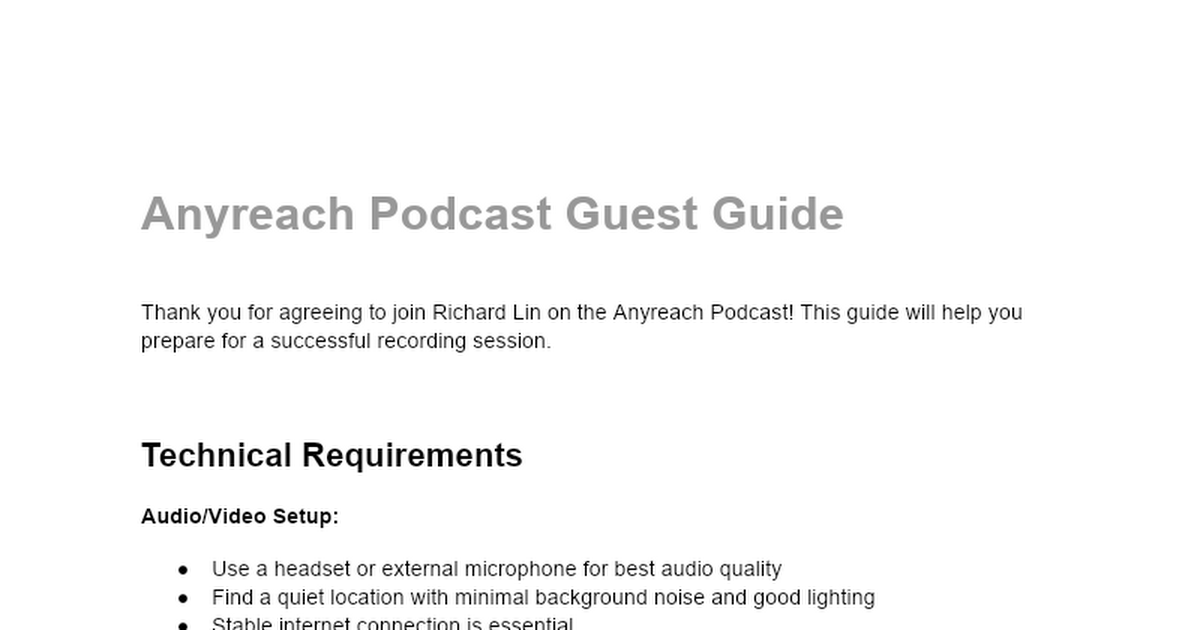
All recipes are built in Attio’s no-code editor, so adjusting copy or timing is as easy as drag-drop.
5. Recording & Post-Production: From Long Form to 30 Shorts—Automatically
Riverside for Capture
Separate local tracks ensure studio quality even on shaky Wi-Fi. Timestamps feed into our editor’s worksheet for quick reference.
Single Upload → Opus Clips
As soon as the final edit hits YouTube, Opus crawls it, detects high-engagement moments, and outputs 30–40 clips in 9:16 and 1:1 ratios.
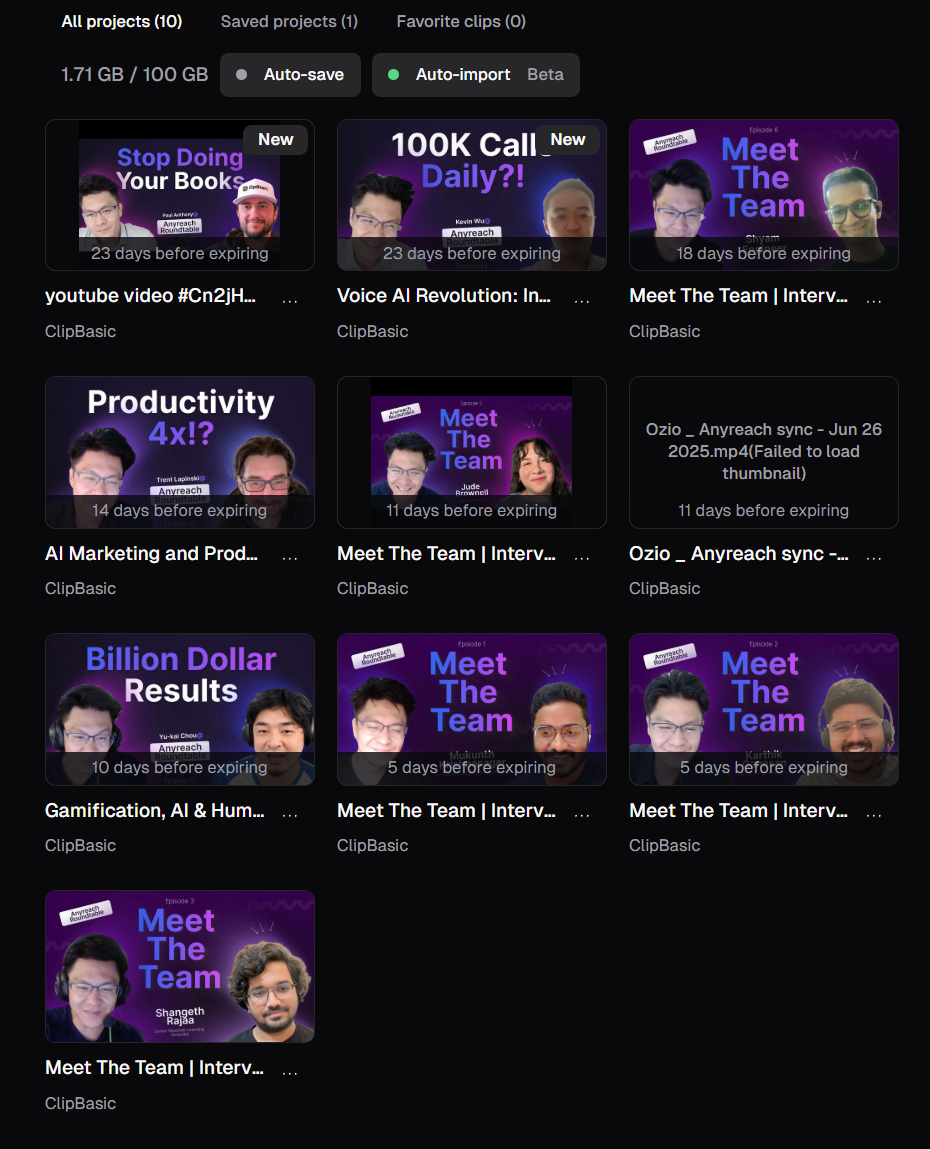
Smart File Naming
Each clip is labeled with its topic (“AI-Hiring-Tip-#3”) so guests can cherry-pick without watching all 30.
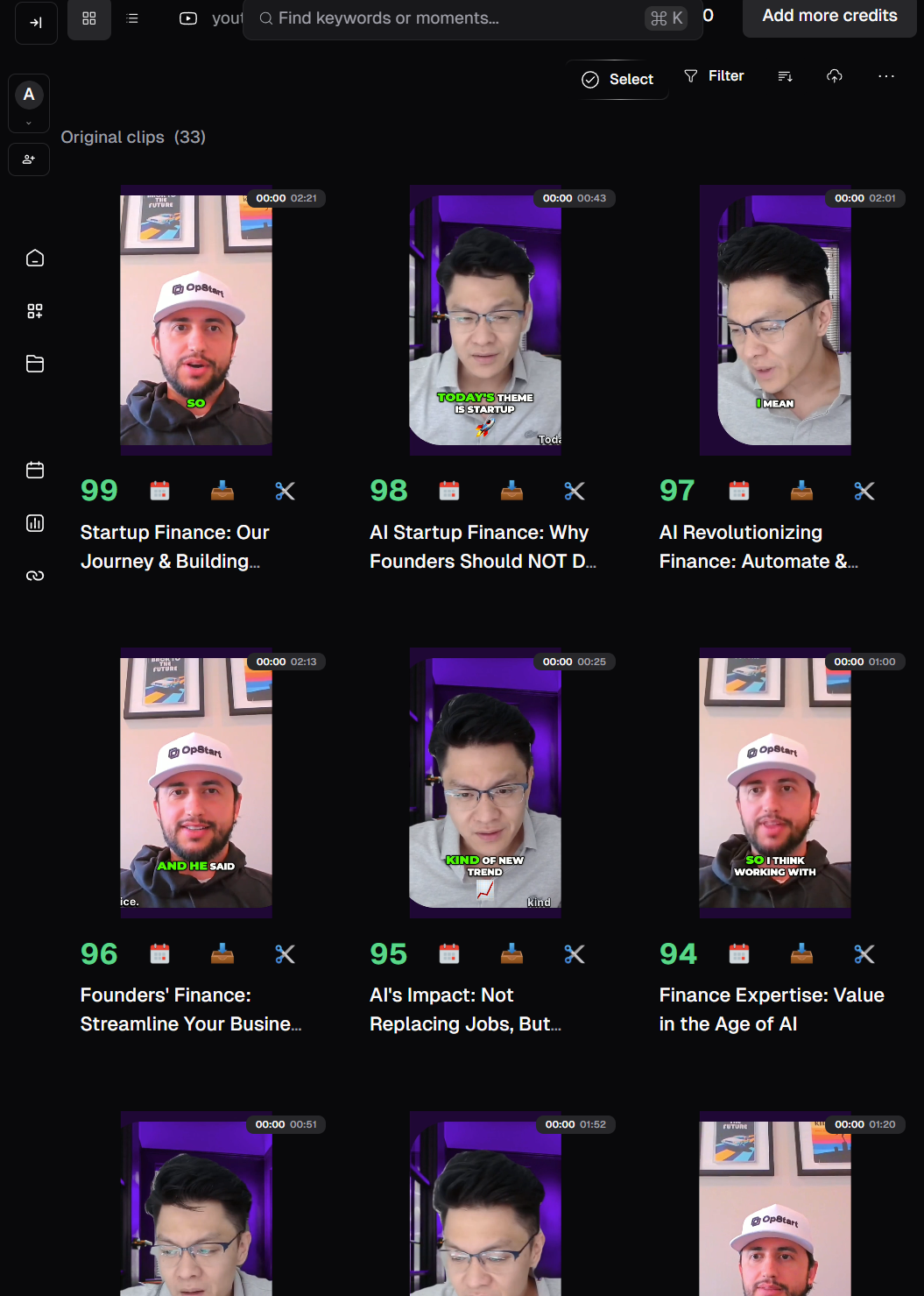
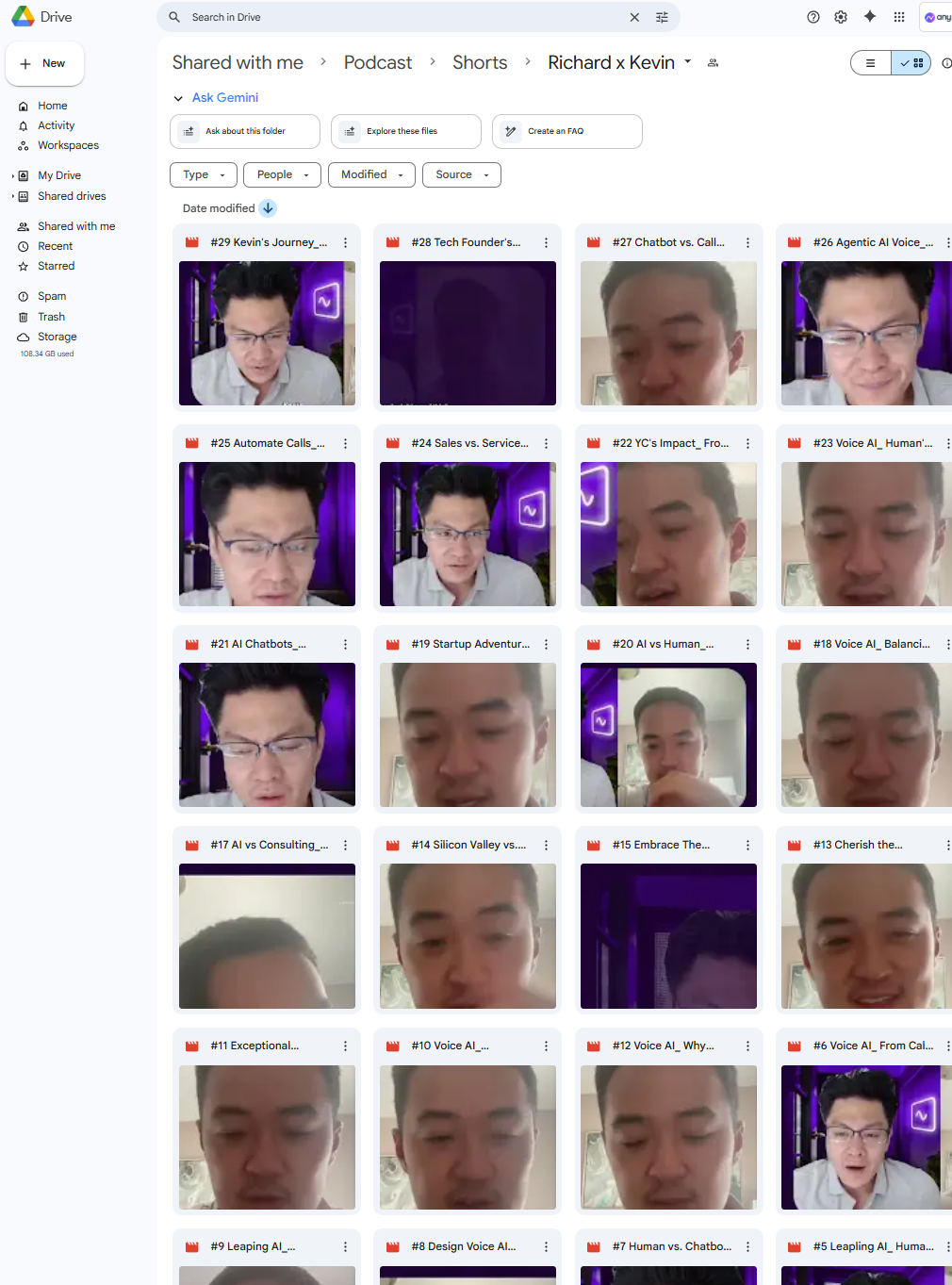
Auto-Publish & CRM Injection
Shorts can be scheduled straight to YouTube. The Drive folder link flows back into Attio, which in turn populates the “Episode Live” email.
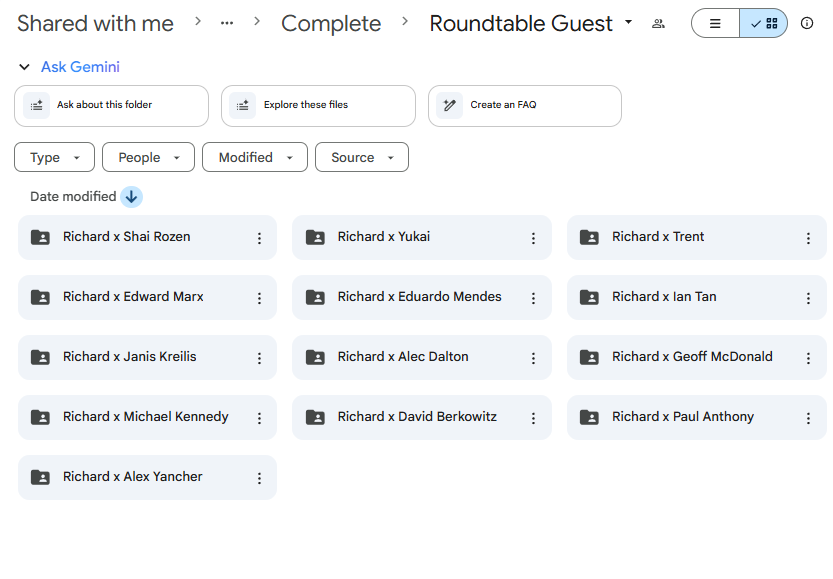
Guest Amplification Built In
Follow-up cadence (T+1 day, T+1 week, T+1 month) reminds the guest to post clips and includes UTM-tagged links so we can attribute traffic.
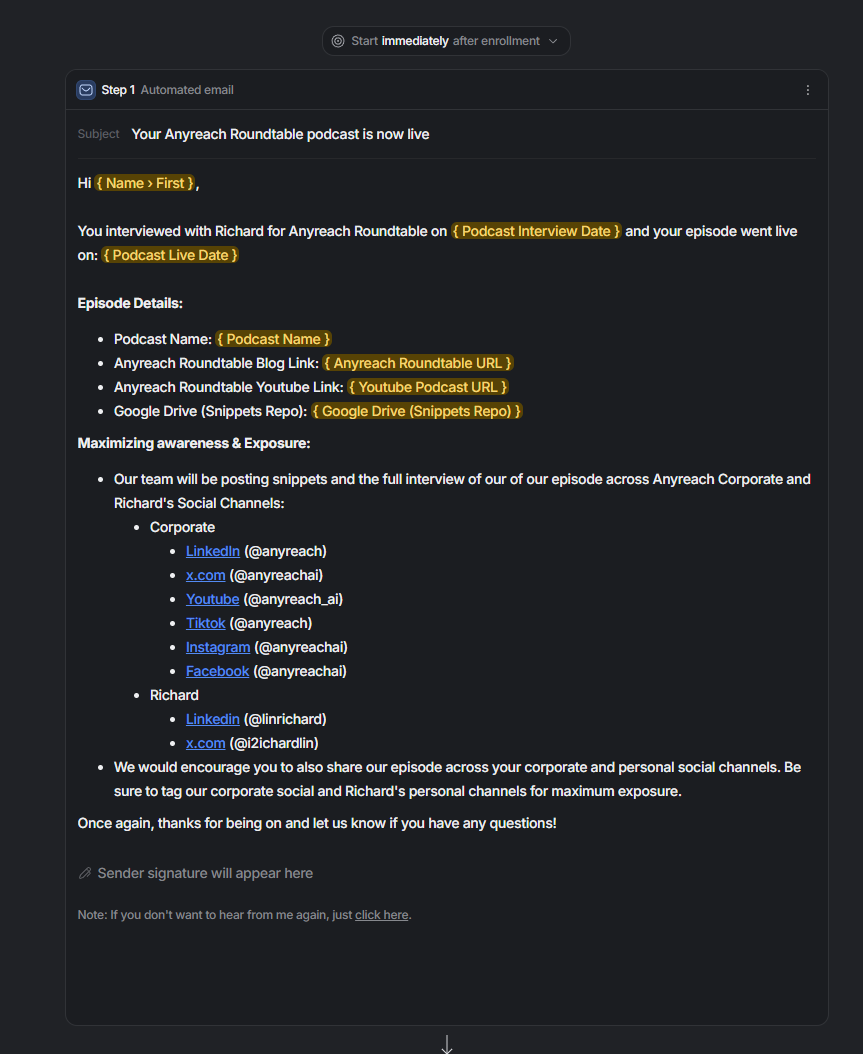
6. Radical Transparency & Auditability
- Ever wonder where that Riverside URL went? Open the record—every touchpoint is time-stamped.
- Need to prove a quote’s source? It’s in the dossier, hyper-linked.
- Curious if the follow-up email fired? Check the sequence log.
Because the entire system is field-driven, there’s no “magic” step hiding in someone’s inbox. New team members ramp in a day, not weeks.
7. Outcomes So Far
| Metric | Pre-Automation | Post-Automation | Δ |
|---|---|---|---|
| Guest-to-Live cycle time | 14 days | 4 days | ↘ 71 % |
| Producer prep per episode | 3 h 15 m | 22 m | ↘ 88 % |
| Outreach reply rate | 28 % | 40 % | +12 pp |
| Average social assets per episode | 4 | 30+ | 7.5× |
Qualitative wins: guests rave about our “white-glove experience,” while the marketing team finally has a steady pipeline of snackable video.
8. Under the Hood: Full Stack Snapshot
| Layer | Tool | Why It Matters |
|---|---|---|
| CRM & Automations | Attio | All data + workflows in one engine |
| Recording | Riverside | 48 kHz audio, 4K video, browser-based |
| AI Functions | OpenAI via Attio Columns | Deterministic, schema-checked outputs |
| Clip Factory | Opus Clips | AI-driven highlight detection & auto-publish |
| Comms | Slack | Real-time production alerts |
| Hosting | YouTube & Blog CMS | SEO + distribution |
We purposely chose tools with robust APIs so future layers—transcription, multilingual dubbing, dynamic ad stitching—can slot right in.
9. Podcast Checklist
✅ Checklist with Benchmarks
🎧 Audio Fidelity
- [ ] Studio mic used (e.g., Shure SM7B, Rode NT1)
- [ ] Audio is clean (noise floor under –60 dB)
- [ ] Mic levels consistent across speakers (–16 LUFS target)
✂️ Clean Editing
- [ ] Filler words and awkward pauses removed
- [ ] Max 2 seconds of silence between sections
- [ ] Branded intro/outro (5–15 sec) included
🧩 Segmented Structure
- [ ] Episode divided into at least 3 clear sections (e.g., News → Interview → Summary)
- [ ] Transitions between segments are smooth
📝 Show Notes & Timestamps
- [ ] Show notes written with 3–5 helpful links
- [ ] Each segment timestamped and labeled for platforms (Spotify, YouTube)
🔍 Technical Accuracy
- [ ] All terminology verified and clearly explained
- [ ] 80%+ of content at expert-level, 20% simplified for clarity
🎵 Audio Branding
- [ ] Theme music consistent with past episodes
- [ ] Intro/outro phrasing matches podcast tone/brand
🖼️ Multi-Format Output
- [ ] At least 1 audiogram/video clip created for social
- [ ] Written blog/newsletter recap published
🧑💻 Guest Audio Quality
- [ ] Guest used Riverside/Zencastr or was prepped for quality audio
- [ ] Guest audio >128kbps and free of echo/clipping
🗣️ Listener Interaction
- [ ] At least 1 listener Q&A or shoutout featured (monthly minimum)
- [ ] Open call for feedback/questions in episode or notes
🏷️ Metadata & SEO
- [ ] SEO-optimized title with keywords (e.g., “LLM,” “AI,” “Prompt Engineering”)
- [ ] 150+ word description with relevant hashtags and links
10. Want a Front-Row Demo?
We love talking shop. Give us 15 minutes and we’ll walk you through:
- Importing a cold lead list
- AI agents spinning up research & scripts in real time
- A mock recording flowing through post-production
- The final “Episode Live” email—assets and all
Ready to see how frictionless podcasting can be? [Get in touch] and we’ll fire up a sandbox just for you.
Because when the ops disappear, the conversation shines.



![[AI Digest] Access Blocked Today](/content/images/size/w600/2025/07/Daily-AI-Digest.png)